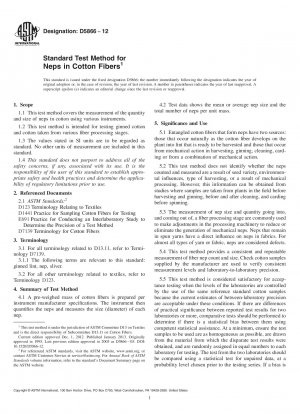ASTM D5866-12
Standard Test Method for Neps in Cotton Fibers
- Standard No.
- ASTM D5866-12
- Release Date
- 2012
- Published By
- American Society for Testing and Materials (ASTM)
- Status
- Replace By
- ASTM D5866-12(2020)
- Latest
- ASTM D5866-12(2020)
- Scope
5.1 Entangled cotton fibers that form neps have two sources: those that occur naturally as the cotton fiber develops on the plant into lint that is ready to be harvested and those that occur from mechanical action in harvesting, ginning, cleaning, carding or from a combination of mechanical action.
5.2 This test method does not identify whether the neps counted and measured are a result of seed variety, environmental influences, type of harvesting, or a result of mechanical processing. However, this information can be obtained from studies where samples are taken from plants in the field before harvesting and ginning, before and after cleaning, and carding before spinning.
5.3 The measurement of nep size and quantity going into, and coming out of, a fiber processing stage are commonly used to make adjustments in the processing machinery to reduce or eliminate the generation of mechanical neps. Neps that remain in spun yarns have a direct influence on neps in fabrics. For almost all types of yarn or fabric, neps are considered defects.
5.4 This test method provides a consistent and repeatable measurement of fiber nep count and size. Check cotton samples supplied by the manufacturer are used to verify consistent measurement levels and laboratory-to-laboratory precision.
5.5 This test method is considered satisfactory for acceptance testing when the levels of the laboratories are controlled by the use of the same reference standard cotton samples because the current estimates of between-laboratory precision are acceptable under these conditions. If there are differences of practical significance between reported test results for two laboratories or more, comparative tests should be performed to determine if there is a statistical bias between them using competent statistical assistance. At a minimum, ensure the test samples to be used are as homogeneous as possible, are drawn from the material from which the disparate test results were obtained, and are randomly assigned in equal numbers to each laboratory for testing. The test from the two laboratories should be compared using a statistical test for unpaired data, at a probability level chosen prior to the testing series. If a bias is found, either its cause must be found and corrected, or future test results for that material must be adjusted in consideration of the known bias.
1.1 This test method covers the measurement of the quantity and size of neps in cotton using various instruments.
1.2 This test method is intended for testing ginned cotton and cotton taken from various fiber processing stages.
ASTM D5866-12 Referenced Document
- ASTM D123 Standard Terminology Relating to Textiles
- ASTM D1441 Standard Practice for Sampling Cotton Fibers for Testing
- ASTM D7139 Standard Terminology for Cotton Fibers
- ASTM E691 Standard Practice for Conducting an Interlaboratory Study to Determine the Precision of a Test Method
ASTM D5866-12 history
- 2020 ASTM D5866-12(2020) Standard Test Method for Neps in Cotton Fibers
- 2012 ASTM D5866-12 Standard Test Method for Neps in Cotton Fibers
- 2005 ASTM D5866-05 Standard Test Method for Neps in Cotton Fibers (AFIS-N Instrument)
- 1995 ASTM D5866-95 Standard Test Method for Neps in Cotton Fibers (AFIS-N Instrument)
